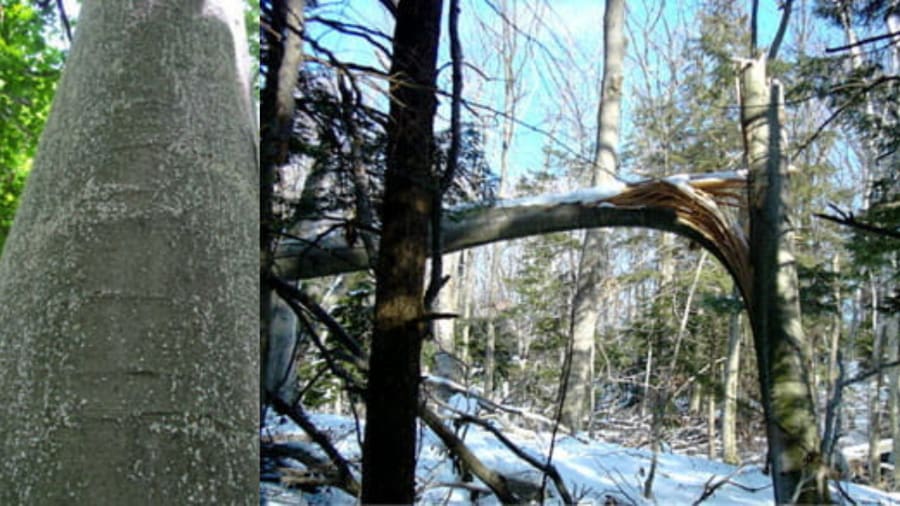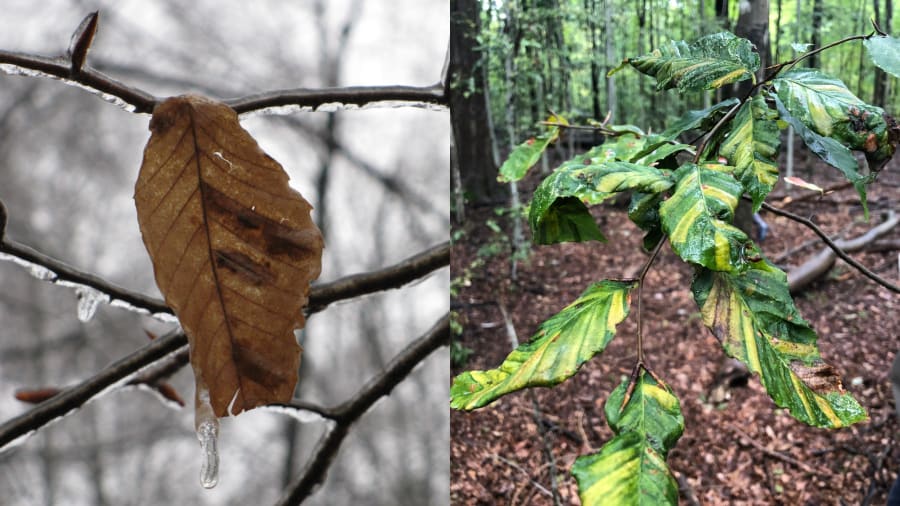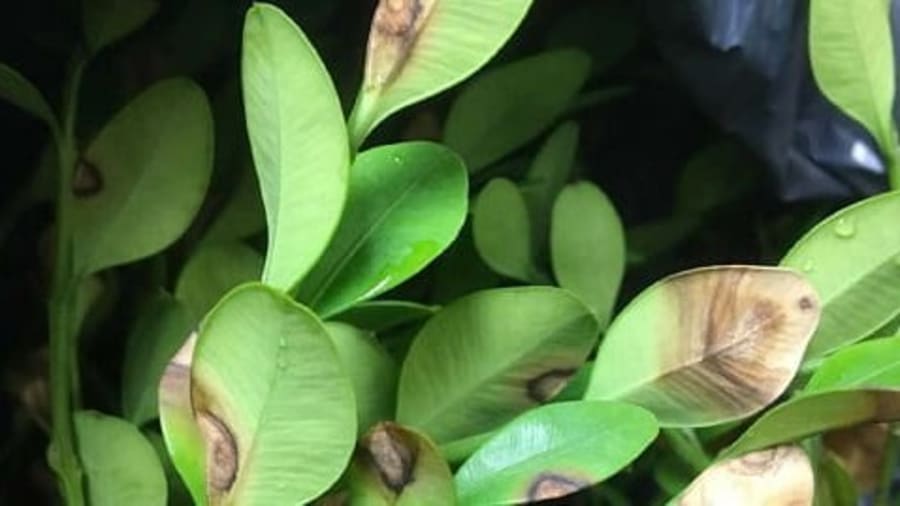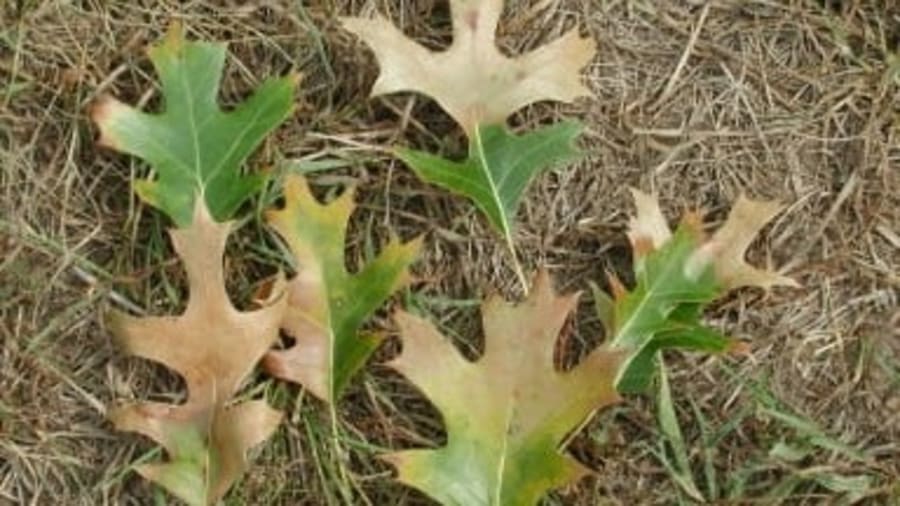There are five invasive diseases that Michigan residents should be aware of and keep an eye out for.
These species have the potential to harm Michigan’s natural resources. Four of them have been detected in the state and the fifth one is just one you should know the symptoms of.
Beech bark disease and beech leaf disease both target species of beech trees. There have already been 2.5 million beech trees killed by beech bark disease so far. The other diseases are boxwood blirhgt, oak wilt and thousand cankers disease.
Thousand cankers disease causes the death of black walnut trees. It has not yet been located in Michigan, but it is on the state’s watch list.
Do you want to learn more about invasive species in Michigan? You can click here for more in-depth coverage on the species that are threatening our state.
Beech bark disease

- Names: Cryptococcus fagisuga + Neonectria spp.
- Status: Detected in Michigan
Beech bark disease is caused by both a sap-feeding scale insect and a fungus. American beech trees are first infested with beech scale. The scale allows for the infection of the Neonectria fungus.
The fungus kills the wood, which blocks the flow of sap. Infected trees will die between three to six years after an infestation. Some infected trees break off in heavy winds before they die, which is called a “beech snap.” The scales are covered with white wool, which turns infested parts of the tree white.
There are 32 million American beech trees in Michigan. At least 2.5 million beech trees have been killed by the disease so far, with most of the loss in the eastern Upper Peninsula. Newly infested beech forests are reported in the lower peninsula every year.
You can click here to learn more about beech bark disease. You can report suspected beech bark disease in Michigan to the DNR Forest Health Division at DNR-FRD-Forest-Health@michigan.gov or by phone at 517-284-5895. You can also report sightings of invasive species to the Midwest Invasive Species Information Network.
Beech leaf disease

- Names: Litylenchus crenatae
- Status: Detected in Michigan
Beech leaf disease is associated with the microscopic worm Litylenchus crenatae, a nematode. The worm enters and spends the winter in leaf buds. This causes damage to the leaf tissue on American, European and Asian beech species.
Trees that are weakened by leaf damage become susceptible to other diseases and can die within six to 10 years after initial symptoms. There are around 37 million American beech trees in Michigan. You can identify them by their smooth bark. They provide food and shelter for wildlife.
Beech leaf disease was confirmed in Michigan for the first time in a small private woodlot in southern St. Clair County in the spring of 2022. Officials believe the disease had been there for more than a year at the time it was discovered.
Symptoms include damaged leaf tissue, dead buds, and darkened, thick tissue bands between leaf bands. The bands create a striped effect on the leaves. It is easier to notice by looking upward at trees on a sunny day. The leaf curling and distortion progress over time, resulting in withered, dried or yellow leaves and a thin canopy. Leaf loss is noticeable in early summer on heavily infested trees.
Very little is known about the disease. It’s unclear if the nematode is the primary cause of the disease or just a carrier of another agent responsible for the disease. There is no known treatment for beech leaf disease. Click here to learn more from the state.
Learn more: Invasive beech leaf disease confirmed in Michigan for 1st time: What to know
Boxwood blight

- Names: Calonectria pseudonaviculata
- Status: Detected in Michigan
Boxwood blight is a fungal disease that attacks boxwood, Japanese spurge, Allegheny spurge, and sweet box. It was first detected in Michigan in three separate incidents in 2018.
The disease can defoliate boxwood plants in nursery production and in the landscape. Fungicides can help protect plants from boxwood blight infection, but they will not cure plants that have already been infected. The fungus can spread via the transport of infected plants that may not show any symptoms at the time they are being shipped.
The fungus that causes boxwood blight produces sticky spores on infected plants and can be moved around by animals, people, or water. The disease can also be spread through contaminated pruning equipment. Spores on the ground remain viable for up to five years.
Pachysandra, a common groundcover plant, is a host of boxwood blight. Boxwood blight causes leaf spots on Pachysandra but does not usually kill the plant. Pachysandra could spread boxwood blight in landscape settings. Sweet box has only shown to cause disease under experimental conditions, according to officials.
What can you do if you have boxwood plants?
- Monitor your plants for disease on a regular basis.
- Use drip irrigation or water plants at the roots.
- Only prune plants when conditions are dry and make sure to sanitize pruning equipment between plants or sections of plants.
- Rake and remove leaf debris.
- Do not use boxwood holiday decorations near boxwoods
- If you find boxwood blight you should remove and destroy infected plants and any plant debris by double bagging the diseased plant and putting it in a landfill or burning it.
You can click here to learn more about boxwood blight in Michigan. Samples can be sent to MSU’s Diagnostic Services Laboratory. The Boxwood Blight Cleanliness Program is an effort to keep infected plants from being distributed, you can learn more here.
Related: Check your boxwood plants: Invasive box tree moth found in Lenawee County
Oak wilt

- Names: Bretziella fagacearum
- Status: Detected in Michigan
Oak wilt kills healthy red oak trees. Once a red oak becomes infected with the fungus, the tree will die and there is no way to save it. There are steps that can be taken to protect other oak trees in the surrounding area from an infected tree.
Oak wilt moves slowly through root systems and travels short distances over land when new spores are moved by beetles from an infected tree to a freshly pruned or injured tree. Symptoms include red oak trees that suddenly drop their leaves in the summer.
While white oak trees can be affected, they are more resistant and less likely to die from the disease.
How can you help? Do not prune oak trees during the growing season. If you do need to prune oak trees, do not prune them between April 15 and July 15. Do not move firewood. Oak wilt is spread by the movement of infected firewood.
You can click here to learn more about oak wilt in Michigan. You can report sightings to the DNR at DNR-FRD-Forest-Health@michigan.gov or by phone at 517-930-4294. You can also report sightings of invasive species to the Midwest Invasive Species Information Network.
View: Find oak wilt in Michigan through this interactive map
Thousand cankers disease

- Names: Pityophthorus juglandis + Geosmithia morbida
- Status: Not detected in Michigan
Thousand cankers disease (TCD) is a disease that primarily affects black walnut trees. The disease is the result of the combination of the fungus Geosmithia morbida and the walnut twig beetle.
When the beetles feed on the tree branches, they introduce the fungal pathogen that can cause TCD in live trees. The pathogen kills small areas of tissue, causing cankers on the tree. As more cankers form, the branches die and eventually, the entire tree dies.
The beetle and fungus can be transported into new areas in walnut logs, firewood, and staves used for woodworking. Michigan’s forests have around 8.5 million black walnut trees. The trees have an economic value of more than $86 million and they serve as a food source for birds, mammals and other wildlife.
You can click here to learn more about thousand cankers disease in Michigan. You can report sightings via email to MDA-Info@michigan.gov or call the MDARD Customer Service Center 800-292-3939. You can also report sightings of invasive species to the Midwest Invasive Species Information Network.



